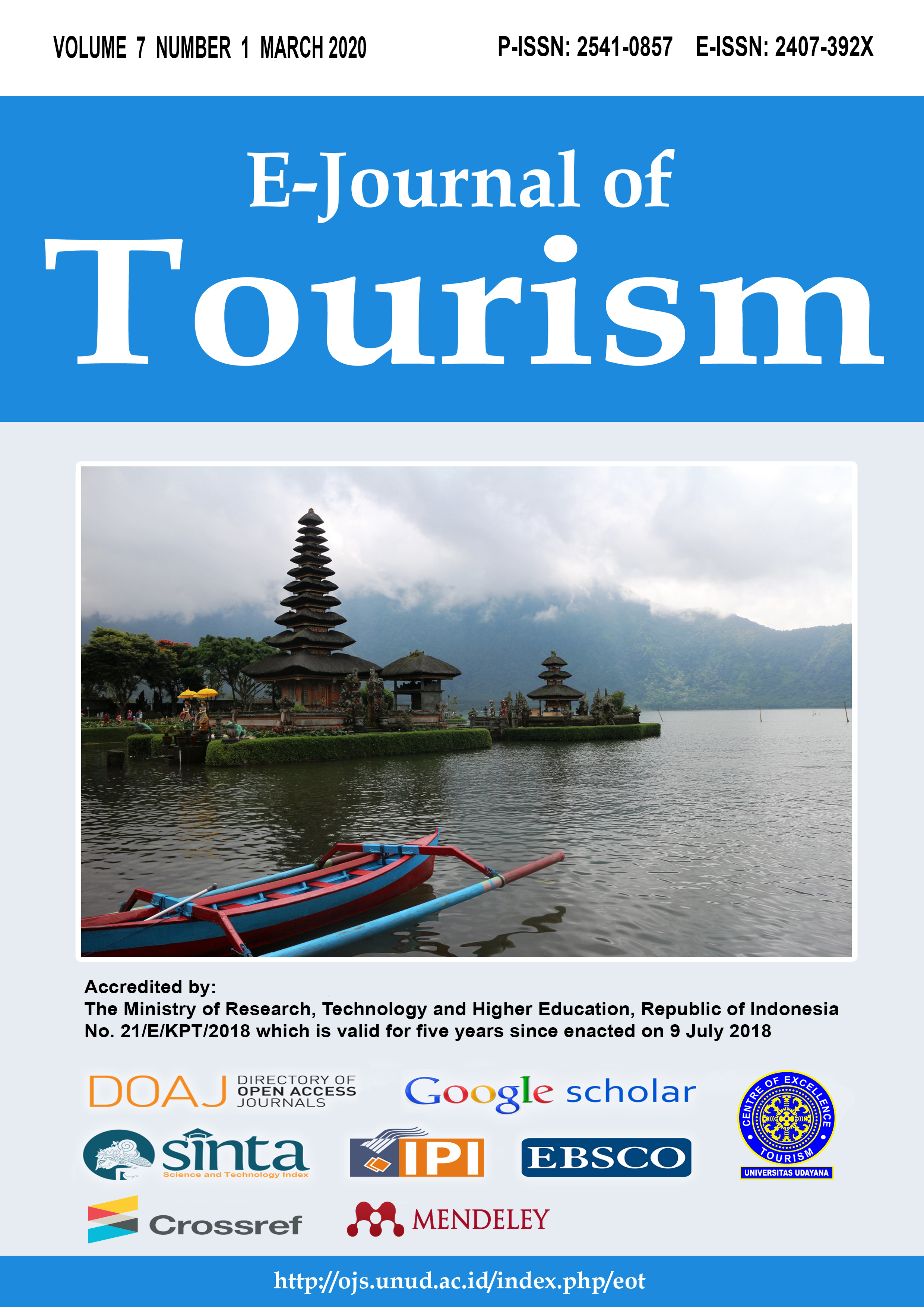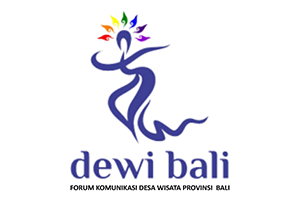Analysis of Perceived Factors Affecting Tourist Satisfaction in Mountain Tourism: A Study in Mount Papandayan, Indonesia
Abstract
Although the mountain is a popular tourist destination, research regarding mountain tourism is still limited. Over the years, researches on tourist satisfaction covered a more general context of tourism, without specifically analyzing mountain tourism. Therefore, this research aims to investigates factors influencing tourists’ satisfaction on mountain tourism, with Mount Papandayan, Garut Regency, West Java, Indonesia, as a case. Eleven variables regarding tourist satisfaction were derived from several interviews with Mount Papandayan’s management staff and 30 tourists that were hiking and camping on Mount Papandayan. A sample of 100 respondents, who were the Mount Papandayan’s tourists that had been hiking and camping, completed questionnaires. Exploratory factor analysis (EFA) and confirmatory factor analysis (CFA) was used to analyze the data. The results show that there are three factors that affect tourist’s satisfaction in mountain tourism, which are ‘infrastructure and facilities’, ‘natural resources’, and ‘mountain area’s atmosphere’, while CFA validated the model fit. The results also indicated a significant relationship between the three factors. This research provides an opportunity for broader research opportunities in mountain tourism, especially in tropical countries.
Keywords : mountain tourism, satisfaction, EFA, CFA
Downloads
References
Baker, D. A., & Crompton, J. (2000). Quality, satisfaction, and behavioral intentions. Annals of Tourism Research, 27(3), 785-804.
Becken, S. (2010). The importance of climate and weather for tourism. Land Environment and People (LEaP) background paper, Lincoln University, 4-13.
Beedie, P., & Hudson, S. (2003). Emergence of mountain-based adventure tourism. Annals of tourism research, 30(3), 625-643.
Bernini, C., Cagnone, S. (2014). Analysing tourist satisfaction at a mature and multi-product destination. Current Issues in Tourism, 17(1), 1-20.
Brown, J. D. (2000). What issues affect Likert-scale questionnaire formats. Shiken: JALT Testing & Evaluation SIG Newsletter, 4(1), 27-30.
Byrne, B. M. (2013). Structural equation modeling with LISREL, PRELIS, and SIMPLIS: Basic concepts, applications, and programming. Psychology Press.
Coghlan, A. (2012). Linking natural resource management to tourist satisfaction: a study of Australia's Great Barrier Reef. Journal of Sustainable Tourism, 20(1), 41-58.
Cohen, J. (2013). Statistical power analysis for the behavioral sciences (2nd ed). Routledge.
Del Bosque, I. R., San Martin, H. (2008). Tourist satisfaction: A cognitive-affective model. Annals of Tourism Research, 35, 551-573.
Dornier, R., & Selmi, N. (2018). Peer-to-peer accommodation and sustainability in mountain areas. Worldwide Hospitality and Tourism Themes, 10(2), 259-266.
Faulkner, B., Oppermann, M., & Fredline, E. (1999). Destination competitiveness: An exploratory examination of South Australia’s core attractions. Journal of Vacation Marketing, 5(2), 125-139.
Fornell, C. R., & Lacker, D. F. (1981). Two structural equation models with unobservable variables and measurement error. Journal of Marketing Research, 18(1), 39–50.
Fredman, P., & Heberlein, T. A. (2003). Changes in skiing and snowmobiling in Swedish mountains. Annals of tourism research, 30(2), 485-488.
Fredman, P. (2008). Determinants of visitor expenditures in mountain tourism. Tourism Economics, 14(2), 297-311.
Frochot, I., Elliot, S., & Kreziak, D. (2017). Digging deep into the experience–flow and immersion patterns in a mountain holiday. International Journal of Culture, Tourism and Hospitality Research, 11(1), 81-91.
Godde, P. M., Price, M. F. and Zimmermann, F.M. (2000). Tourism and Development in Mountain Regions, Wallingford, UK: CABI Publishing.
Gronroos, C. (1990). Service management and marketing: Managing the moments of truth in service competition. Lexington: Lexington Books.
Hadi, N. U., Abdullah, N., Sentosa, I. (2016). An easy approach to Exploratory Factor Analysis: marketing perspective. Journal of Educational and Social Research, 6(1), 215.
Johns, N., Avci, T., & Karatepe, O. M. (2004). Measuring service quality of travel agents: evidence from Northern Cyprus. The Service Industries Journal, 24(3), 82-100.
Jovanović, S., & Ivana, I. L. I. Ć. (2016). Infrastructure as important determinant of tourism development in the countries of Southeast Europe. Ecoforum Journal, 5(1).
Kalia, P. (2017). Service quality scales in online retail: methodological issues. International Journal of Operations & Production Management, 37(5), 630-663.
Kozak, M., & Rimmington, M. (2000). Tourist satisfaction with Mallorca, Spain, as an off-season holiday destination. Journal of travel research, 38(3), 260-269.
Messerli B. & Ives, J. D. (1997). Mountains of the World: A Global Priority. Carnforth: Parthenon.
Mihalič, T. (2013). Performance of Environmental Resources of a Tourist Destination. Journal of Travel Research, 52(5), 614–630.
Nepal, S. K. (2003). Strategies for mountain ecotourism development, in Ranga M. and Chandra D. (Eds) Tourism and Hospitality in the 21st Century, 135–154. New Delhi: Discovery Publishing.
Nepal, S. K., & Chipeniuk, R. (2005). Mountain tourism: Toward a conceptual framework. Tourism Geographies, 7(3), 313-333.
Oliver, R. L. (1993). Cognitive, affective, and attribute bases of the satisfaction response. Journal of Consumer Research, 20(3), 418-430.
Oliver, R. L. (1980). A cognitive model of the antecedents and consequences of satisfaction decisions. Journal of Marketing Research, 17(4), 46-49.
Silva, C., Kastenholz, E., & Luís Abrantes, J. (2015). Residents’ perceptions of mountain destinations. Marketing Places and Spaces. UK: Emerald Group Publishing Limited.
Smethurst, D. (2000). Mountain geography, The Geographical Review, 90(1), 35–56.
Suryawardani, I. G. A. O., Wiranatha, A. S., Bendesa, I. K. G., Antara, M., & Gravari-Barbas, M. (2017). A Structural Model of Foreign Tourists’ Loyalty in Nature-Based Tourism in Bali. International Journal of Applied Business and Economic Research, 15(19), 195-214.
Tasci, A. D., Gartner, W. C., & Cavusgil, S. T. (2007). Measurement of destination brand bias using a quasi-experimental design. Tourism Management, 28(6), 1529-1540.
Wiranatha, A. S., Bendesa, I. K. G., & Suryawardhani, I. G. A. O. (2018). Model of Foreign Tourists’ Loyalty in Cultural and Heritage Tourism in Bali. Global and Stochastic Analysis, 5(8), 73-92.
Wiranatha, A. S., Suryawardani, I. G. A. O., Bendesa, I. K. G., & Antara, M. (2016). Model of Foreign Tourist’s Loyalty on Marine Tourism to Visit Bali. International Journal of Multidiciplinary Education Research, 5(3), 1-16.
Wirtz, J., Mattila, A. S., & Tan, R. L. (2000). The moderating role of target-arousal on the impact of affect on satisfaction—an examination in the context of service experiences. Journal of retailing, 76(3), 347-365.

This work is licensed under a Creative Commons Attribution 4.0 International License.
The copyright of the received article shall be assigned to the journal as the publisher of the journal. The intended copyright includes the right to publish the article in various forms (including reprints). The journal maintains the publishing rights to the published articles.




















